Yasser Seirawan's Chess Career
At the age of 12 Seirawan learnt to play chess, for modern standards relatively late. The four-time US champion was born on March 24, 1960 in Damascus as the son of a Syrian father and an English mother. Due to political unrest, the family left Syria in March 1964 to go first to England and then three years later to the USA, where Seirawan's father worked for Boeing in Seattle. In 1968 the parents separated and Seirawan lived with his mother in various American cities until they moved back to Seattle in 1972.
The frequent changes between cities, continents and cultures do not seem to have harmed Seirawan. He is multi-talented, interested and ambitious:
"I don't know where my competitive nature comes from. Whether in sports, school or as a newspaper boy, I endeavored to be the best. Not just best, but excellent. Yes, I wanted to win and just within the rules, but within the spirits of the rules as well. If I felt a referee made a bad call, I would give the ball back to the other team, not always endearing myself to my teammates in the process." (Yasser Seirawan, Chess Duels: My Games with the World Champions, Everyman 2010, p. 9-10)
He discovers chess in 1972, the year in which Bobby Fischer becomes world champion. A neighbour explains the rules to Seirawan, they play a game, Seirawan loses which wakes his ambition. Soon he regularly visits the chess cafés in the university district of Seattle and makes a steep career.
At the age of 13 he becomes American Junior Champion, at 19 he becomes Junior World Champion and in January 1980 Grandmaster, back then after Fischer, Spassky and Henrique Mecking the fourth youngest Grandmaster of all times. These successes helped Seirawan to an award that only few chess players receive: In 1980, the American Playboy named him "Bachelor of the Year". Today, Seirawan is married to Yvette Nagel, the daughter of a well-known Dutch politician, and lives in Holland and the USA.
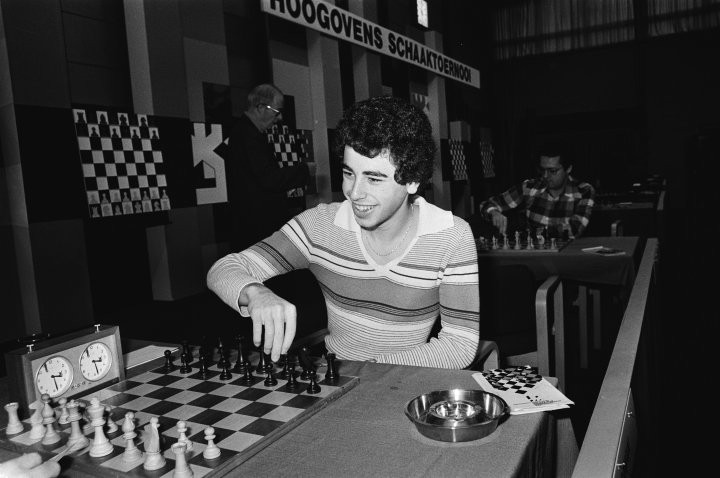
Yasser Seirawan at the Hoogeven tournament 1980 | Photo: Fernando Pereira / Anefo / CC0
Seirawan's career did not progress quite as rapidly as it did after its brilliant start, but over the following years he was able to establish himself as one of the world's top players and qualified twice for the Candidates Matches. He is also successful as an author. He writes a number of entertaining and popular chess books and from 1988 to 2000 he published the magazine Inside Chess.
At the same time, he is a figure whose voice carries weight in the world of chess as a provider of ideas, mediator, organizer and advisor. It is no coincidence that Seirawan once was a second of Korchnoi but also managed to win the trust of Kasparov and Karpov and over the years has worked with them again and again.
Seirawan has retired from tournament chess but is still very present in the world of chess. His deep understanding, his calm, easy-going, yet passionate nature and his soft voice make him a popular commentator, and he regularly comments top tournaments all over the world — with expertise, enthusiasm, good humour and an inexhaustible treasure of anecdotes.
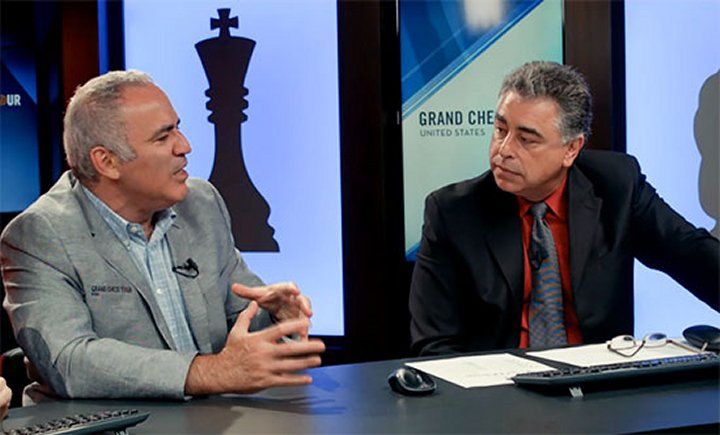
Former rivals: Garry Kasparov and Yasser Seirawan as commentators for the Grand Chess Tour 2015 | Photo: Screenshot
Chess Duels: Seirawan's about his chess career
Chess passion also runs through Seirawan's book Chess Duels, which he published in 2010, and in which he looks back on his chess career. The central theme of the book are his encounters with and his games against the World Champions.
"In my career I have been blessed. I have met and spoken with Max Euwe and Mikhail Botvinnik, analyzed with Robert James Fischer and played against Vassily Smyslov, Mikhail Tal, Tigran Petrosian, Boris Spassky, Anatoly Karpov and Garry Kasparov." (Chess Duels, p. 12)
In his honest and open annotations Seirawan gives an amazingly candid insight into how top grandmasters think, how strongly they play, how much they see during the game and how much they overlook.
"Coupling stories and games together made this book much more fun to write, and, I hope, fun to read. It turns out that a chess career is much like an interesting game – not as neat and tidy, simple or easy to follow as some would wish. My hope is that this book is all the better for not being a tidy work." (Chess Duels, p. 13)
Seirawan observes closely, analyses precisely and has the courage to speak his mind, but above all he is a gifted narrator. He tells exciting, lively, entertaining stories with an eye for detail and can bring places, people and situations to life in just a few strokes. For example when he remembers how he went to Vancouver with friends in 1975 to watch Keres play:
"The first truly world-class chess player I ever saw was Paul Keres. It was in 1975. Vancouver, a beautiful city just across the border from Seattle, hosted a large open tournament. ... With the event about to begin, friends were driving up for the day to watch the opening round. I caught a ride as well. Our eyes were all glued on Paul Keres as we watched his every move. He was a well dressed, dignified man with what might be called a noble bearing. He deeply impressed our whole party. ... It was a thrill to watch a world-class player in action. His manner, his bearing, his unhurried approach to the position, the accuracy of his moves, and the precision and manner in which he physically played his moves all made a deep impression. I was especially drawn to observing his physical movement of the pieces, as he carefully put them correctly in the middle of the square so as not to annoy his opponent. In fact, I went home to practice so that I could mimic his movements as well and to endeavor, as best I could, to play chess 'properly' at the board; ... In short, I wanted to be world class and to behave like a world-class player. I wanted to be, at least in manner, like Paul Keres." (Chess Duels, p. 56-57)
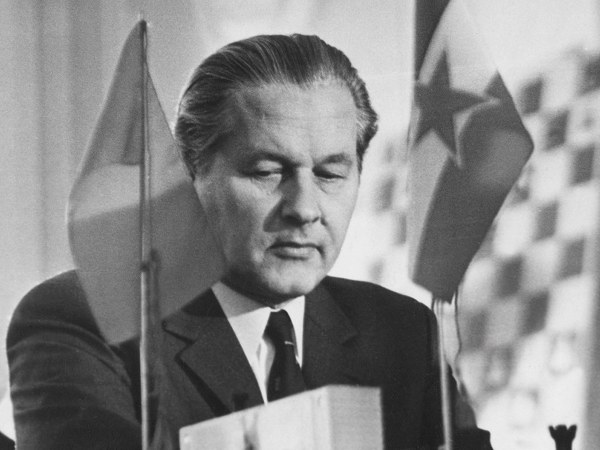
Paul Keres
But for all his enthusiasm for chess and its greats — Seirawan avoids hero worshipping. He portrays his grandmaster colleagues warm-heartedly, but also with an eye for their weaknesses and peculiarities. For example when he tells how Karpov refused to shake hands with Lev Alburt, who emigrated from the Soviet Union, during the USA vs Soviet Union match at the Chess Olympiad 1980 in Malta.
I found myself disappointed with Karpov over this incident. Many years later I asked him about it. "'Why not just shake Lev's hand?’ I innocently asked. His explanation went on to show how many worlds apart we lived: 'Yasser, those were the days of the Soviet Union. Keep in mind we were all being constantly watched. Everything we did and said was in some way monitored or 'recorded'. Lev was a defector. According to the State, officially a criminal. If I had been seen shaking his hand, it would have been reported and I would face an inquisition and would have to explain myself. … It would be a black mark on my record.'
Seirawan comments: "Viewed from that perspective, I could understand Anatoly's decision. I wouldn't want a black mark on my CIA record. Hmm, do I have a CIA record?" (Chess Duels, p. 186<9
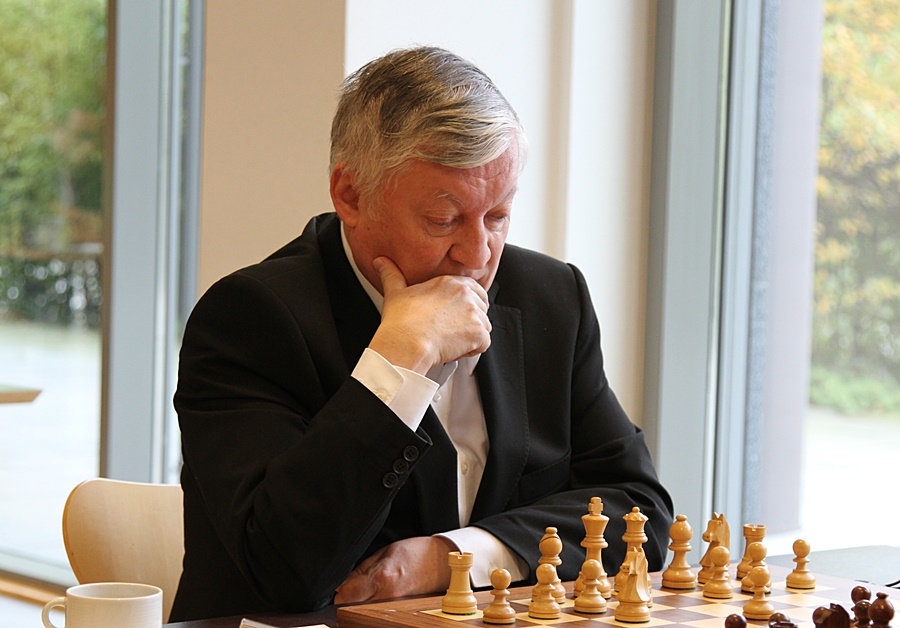
Many years later: Anatoly Karpov while playing in the German "Bundesliga" | Photo: Georgios Souleidis
Seirawan does not hide his own mistakes and weaknesses either, for example when he reveals how he and the American grandmaster Larry Christiansen once tried to play a trick on Karpov and Kavalek during a bridge game, or how Seirawan once offended Kasparov with an undiplomatic remark about mother-son relationships.
With its anecdotes, stories and portraits Chess Duels is a fascinating insider report about current chess history. But it is Seirawan's art of storytelling and his passion for chess that turns it into one of the most interesting chess books of recent years.
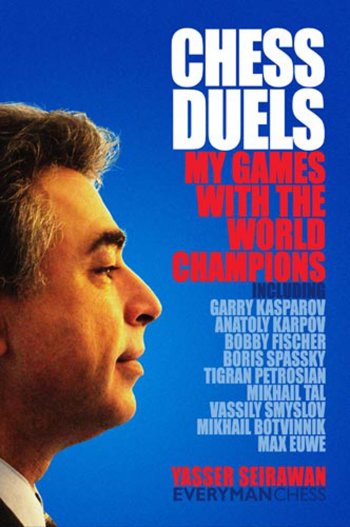
Yasser Seirawan
Chess Duels: My Games with the World Champions
432 pages, 2010
Not to forget the games. Here are two typical examples that show how Seirawan annotates — bitter defeats and brilliant victories.
It’s a problem every player encounters when he stands better in a game: how to convert his plus into a full point? In this DVD the author answers this difficult question of chess strategy, considering both the psychological aspects of the realisation of an advantage and the technical methods.
Seirawan writes:
"One of those really, really painful defeats suffered while having the worst event of your life. … Before leaving Linares 1983 let us toss in one final straw to show how angry the gods were with me. For some reason in 1982/1983 I was tempted to write a novel. A romance/adventure. Surprise! The story came to me in a flood of inspiration, and I would find myself scribbling away for hours at a time over several months. I would buy one of the multi-ringed notebooks popular amongst college students and write my story. First filling one, then another and finally completing my novel with five thick A4-sized ringed notebooks. … Up till this event I had been transporting them in my 'carry-on-luggage', but now the novel was finished. It made sense to put the bulky notebooks into my 'check-in-luggage' for the flight leaving Madrid. My check-in-luggage from my Madrid flight never arrived. I was reimbursed by an insurance company for the checked bag, but my novel was lost. Naturally as it was all done in long hand, I had no copies... (It would be 22 years before I would take up the novel again.)" (Chess Duels, p. 139)
In the following encounter Seirawan had more luck. In 1982, he won a fine and theoretically important game against Karpov, who was reigning World Champion at that time.
For a long time Seirawan was one of the best players in the world. And he still is one of the best and most interesting commentators in the world of chess.




























